CAA News Today
International News: The Treasures of the Punjab Archives, Lahore, Pakistan
posted by CAA — September 28, 2020
The following article was written in response to a call for submissions by CAA’s International Committee. It is by Kanwal Khalid, Director of the Punjab Archives, Lahore, Pakistan, and an alumna of the CAA-Getty International Program.
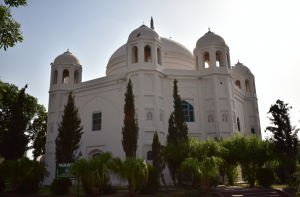
Figure 1. The Punjab Archives, housed in the Tomb of Anarkali, a building from the reign of Mughal Emperor Jahangir (1605-1627). (All photographs in this article provided by the author)
Having spent my career as a university professor, I recently was appointed the director of the Punjab Archives in Lahore. This rich collection is one of the best in South Asia and I am pleased to share a description of the institution, which also includes a library and museum, with readers of CAA News, who will soon be able to access many of the collection’s materials online.
The history of every nation is important and documents that reveal a nation’s history become increasingly precious over time. The majority of these documents are held in archives—collections that are both accumulations of historical data and repositories of record. Pakistan contains many rich archival collections: The National Archives of Pakistan and the National Documentation Centre, both located in Islamabad; the Sindh Archives in Karachi; and the Baluchistan Archives in Quetta. But the oldest of them all is the Punjab Archives in Lahore, located inside the Tomb of Anarkali.
The Punjab Archives is significant both for the immense value of its holdings and for the historical importance of its building (Fig.1), which was built during the reign of Mughal Emperor Jahangir (1605-1627). It was originally a tomb attributed to a woman named Anarkali, traditionally thought to be a concubine of Jahangir’s. According to the date written on the cenotaph, the monument was completed in 1615. The building has witnessed many ups and downs in its four-hundred-year history. After the annexation of Punjab by the British in 1849, the building was used as storage for documents pouring in from all parts of South Asia that were under the control of the British Raj. Two years later it became a church used for Sunday services, but in 1891 it was declared a record office.
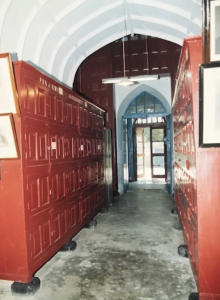
Figure 2. Inside view of the Archives.
Punjab Archives Collection
The Punjab Archives (Figs. 2, 3a-b) holds one of the largest repositories of documents in South Asia and it is responsible for the safekeeping of official documents and records of the Pakistan government. It houses census reports, civil and military gazettes, official files, historical documents, manuscripts, handouts, brochures, pamphlets, maps, notifications, memoranda, lithographs, research papers, journals, magazines, newspapers and periodicals. Many of these cannot be found anywhere else in the world. The archive also includes a fine collection of miniature paintings and seals.
The records in the Punjab Archives date back to the seventeenth century and cover the Mughal, precolonial, colonial and postcolonial eras in South Asia. Primarily the collection consists of:
- Persian Record of Mughal Period, 1629-1858
- Persian Record of Sikh Period, 1799-1849
- Akhbar Darbar-e-Lahore (Daily Court Proceedings of Sikh Rulers), 1835-1849
- Persian Record of British Period, 1809-1890
- Old Persian Newspapers, 1840-1845
- Colonial Agencies Record, 1804-1849
- Record of Princely States in Punjab, 1849-1947
- Record After the Annexation, 1849 to 1947
- Record After Independence, 1947
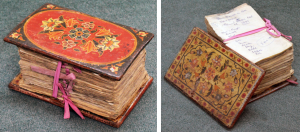
Figure 3a, b. Beautifully illuminated wooden boards used as file holders, first half of 19th century.
The Archival Library
Sir Edward Meclagan served as chancellor of University of the Punjab (1919-1924) and Governor of Punjab (1923). He was a historian whose passion for knowledge is evidenced by his donation of rare and out of print books to the Archives. This initiative led to the establishment of a small but important library that still exists today.
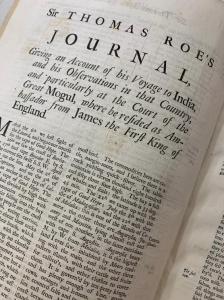
Figure 4. The oldest book in the Archives Library, Sir Thomas Roe’s Journal, 1616.
The collection consists of biographies, reports and travelogues. Currently the library holds more than 70,000 highly valuable reference books. The oldest book is a memoir, Journal of Sir Thomas Roe, which dates to 1616 and recounts the author’s journey to different parts of India (Fig. 4).
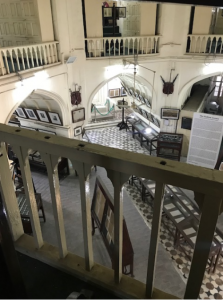
Figure 5. The central hall of the tomb, housing the Archives Museum.
Archives Museum
Another person who played an important role for the Archives was Lord Malcolm Hailey. He went one step beyond his predecessor and established a small museum in 1924 in the central hall of the tomb (Fig. 5). This collection, still maintained today, contains portraits of important Lahore personalities (Fig. 6), along with paintings, prints, maps and lithographs. Mughal Farmans (proclamations), important official letters, old stamps, medals, weapons, and miniatures are also on display (Fig. 7).
Digitization
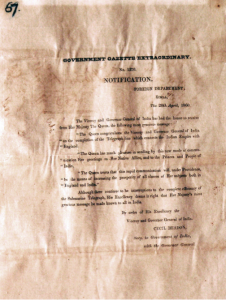
Figure 7. A message from the Queen of England to the viceroy on the completion of the telegraph line to India, 1860.
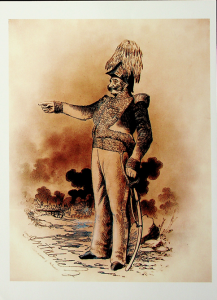
Figure 6. A general of Ranjit Singh’s army, General Avitabile, early 19th century.
For the past several years, the Punjab Archives has been in the process of digitizing its collection to improve accessibility to scholars. Approximately 500,000 pages of historic documents are currently being scanned and catalogued, precluding the need to move the fragile original documents, thus minimizing their wear and tear. A web portal will make these digitized documents accessible under the authorization of the Punjab Archives. This project is a first step towards a long-term strategy of modernizing the Punjab Archives and Libraries. To date, more then 120,000 pages have been digitized. Although the project was scheduled to be completed by June 2021, the Covid-19 pandemic has brought all activities to a standstill. Once completed, the archives online services will be a primary resource for scholars throughout the world. In the meantime we are providing information to any researcher who contacts the Archives Department by email at archivesdirectorate@gmail.com.
Member Spotlight: Pauline Chakmakjian, Visit Kyoto Ambassador
posted by CAA — October 25, 2018
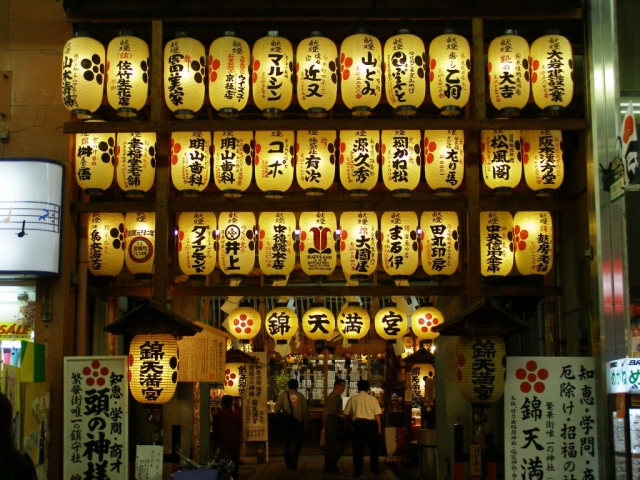
Lanterns lit in Teramachi Street, Kyoto. Photo: Pauline Chakmakjian, MA
Coming up in the spring of next year, we’re pleased to partner with Martin Randall Travel to offer a trip for scholars and artists to Japan. “Understanding Japan for CAA – Arts & Crafts, History, Religion & Traditions” will take place May 9-20, 2019, and will be led by independent Japan scholar and CAA lifetime member, Pauline Chakmakjian.
As a lifetime member and a specialist who lectures on a variety of subjects related to the history, fine arts, and culture of Japan, we wanted to highlight the work Pauline is doing in our Member Spotlight series. Read our interview with her below.
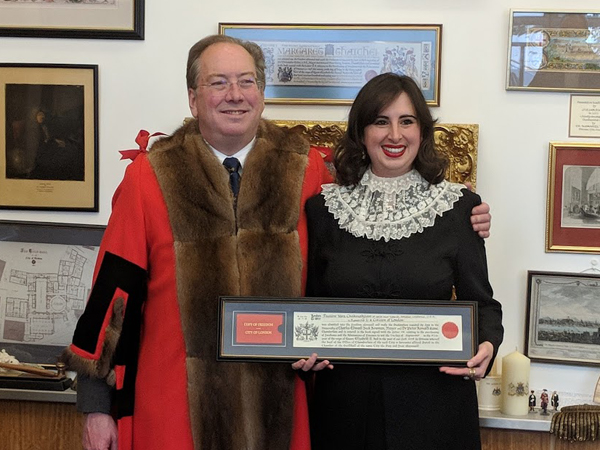
Pauline Chakmakjian, Freeman of the City of London, September 2018. Photo: Pauline Chakmakjian, MA
Joelle Te Paske: Hi Pauline. Thanks for taking the time to answer our questions. So to begin, where are you from originally?
Pauline Chakmakjian: I was born in Los Angeles, California.
JTP: What pathways led you to the work you do now?
PC: My primary passions are travel and the arts. The associations and networks I have developed throughout the years have naturally led to projects that combine this fondness for both cultural variety and the diversity of thought and creativity in various countries, especially Japan.
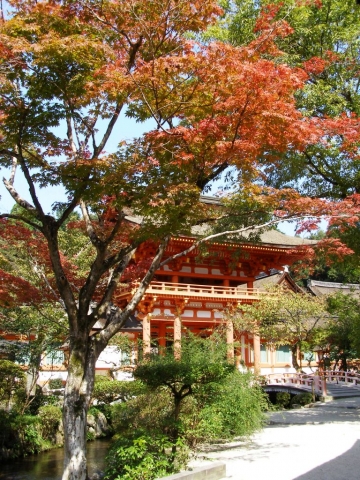
Temple in Kyoto. Photo: Pauline Chakmakjian, MA
JTP: When did you first become a CAA member?
PC: In the summer of 2015, in order to support art and art education.
JTP: Why are you a life member? What has that meant to you?
PC: I think in a long-term manner and carefully select organizations to support that reflect my own interests. With time, becoming a life member will increase in value for me personally, since CAA is focused on art and art makes life exceptionally rich and pleasant. My preference is to support things that encourage creativity and beauty—arts and culture are what makes us human.
JTP: Have you attended CAA conferences?
PC: I have not yet had the pleasure of attending a CAA conference due to my previous travel commitments, but certainly plan to in the future.
JTP: The upcoming tour—“Understanding Japan for CAA – Arts & Crafts, History, Religion & Traditions”—is specifically designed for CAA members. What are you most excited for?
PC: The Kyoto part of the trip, which is towards the end of the tour, of course! In so many ways, the old capital of Kyoto is the heart of Japan, from artistic and culinary traditions that are over one thousand years old, to the eternal backdrop of the tastes and pastimes of the nobility of the Heian-period court, which have cascaded down to influence generations of Japanese people ever since.
JTP: What is the most surprising thing for people to know about Japanese art history?
PC: There are many surprises for those who have never been to Japan or studied its artistic heritage, but if I had to choose one it would be that much of the traditional look or aesthetics of Japanese art are manifestations of the preferences of the upper tiers of the hierarchical class system the Heian court of one thousand years ago, borrowed from the ancient Imperial Chinese court in Chang’an (Xian). The upper two tiers consisted of the Emperor and his retinue of courtiers first, and then the warrior class. These two classes were largely responsible for the distinctive elements and emphases found in Japanese art, from landscape architecture to painting to teaware.
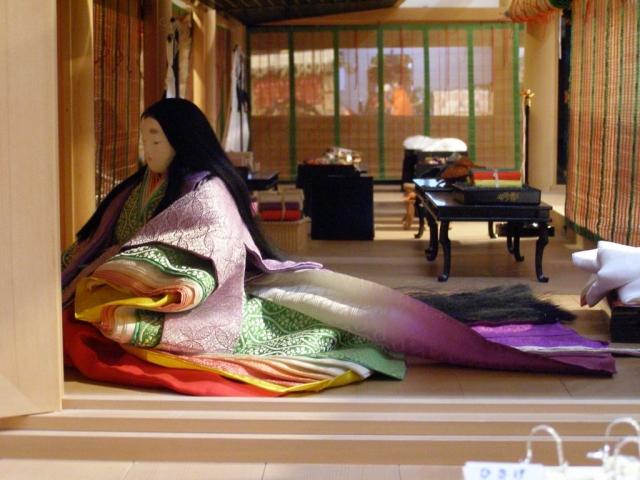
Doll of Lady Murasaki Shikibu, Kyoto. Photo: Pauline Chakmakjian, MA
JTP: Can you tell our members one unforgettable travel story?
PC: Yes, sailing to Easter Island was probably the most adventurous thing I’ve attempted travel-wise. From Tauranga to Hanga Roa I was on board a two-masted brigantine with a permanent and voyage crew for 33 days of sailing across the Pacific. I had always wanted to visit Easter Island and this travel journey combined this dream with my love of classical sailing ships. We were also given instruction on celestial navigation over the course of the sailing experience.
The image that stays in one’s mind and feeling of sailing through a gale force 8 storm at the helm is thrilling. I love paintings by Montague Dawson and this was like one of his paintings in motion.
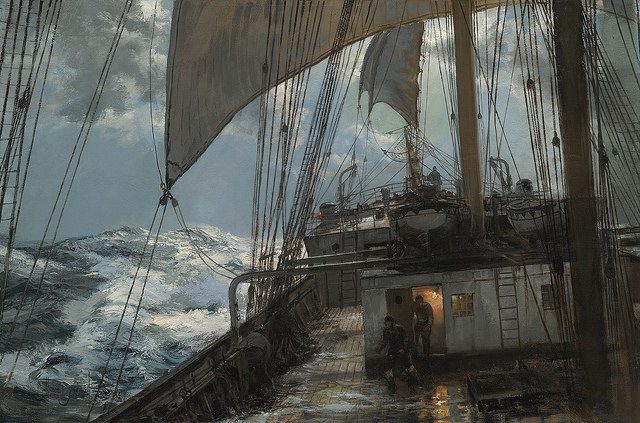
Montague Dawson, A Night at Sea, n.d. (Artwork in the public domain, via Flickr)
JTP: What advice would you give someone looking to partner with travel agencies and lead the sort of tours you do?
PC: A broad range of knowledge on the destination is essential. Though the focus is usually on the arts in terms of cultural travel companies, the tour leader will be asked about the other aspects of the country such as its politics, economy, technology, and other areas, so it’s not enough to simply know about fine art, music, and the performing arts.
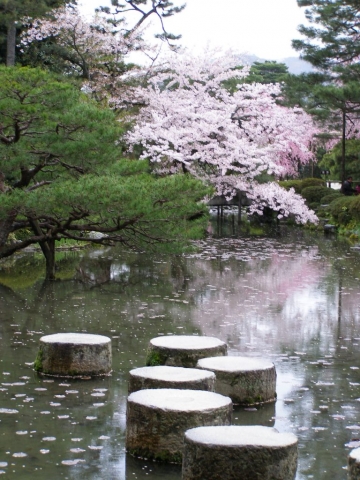
Heian Shrine, Kyoto. Photo: Pauline Chakmakjian, MA
JTP: What is your top recommendation (such as a book, website, or resource) for people working in the arts right now?
PC: There are so many resources both offline and online depending on one’s particular focus or interest in the arts, but I do quite like the international edition of The Art Newspaper. It’s particularly handy for people who travel a lot.
JTP: Do you have a favorite artist or artwork?
PC: This is difficult to answer as there are so many talented people who have created beauty of various types in this world, but the moment that made me want to lecture on art was during my undergraduate studies after I gave a talk for over an hour on The Garden of Earthly Delights by Hieronymous Bosch. This triptych is truly one of the most unique and extraordinary works of art ever made. The eccentricities within each section of the triptych as well as Bosch’s personal associations is what also partly made me curious about private, esoteric networks such as Freemasonry, which I also lecture on.
Pauline Chakmakjian is an independent lecturer on a variety of subjects related to the history, fine arts and culture of Japan. She lectures for private member societies, corporate entertainment, private homes, universities, cruises, charities and other related organizations including lecture tours in Australia and New Zealand. She holds a BA in English Literature during which she was also awarded a Merit Scholarship in Fine Art, a Diploma in Law, an MA in Modern French Studies and is a member of the Honourable Society of the Inner Temple. Pauline was elected onto the Board of the Japan Society of the United Kingdom from 2008–2014 and the Japan Society of Hawaii from 2015–2017. In 2014, Pauline was appointed a Visit Kyoto Ambassador by the Mayor of the City of Kyoto.
CAA Announces Exclusive Member Trip to Japan
posted by CAA — October 09, 2018
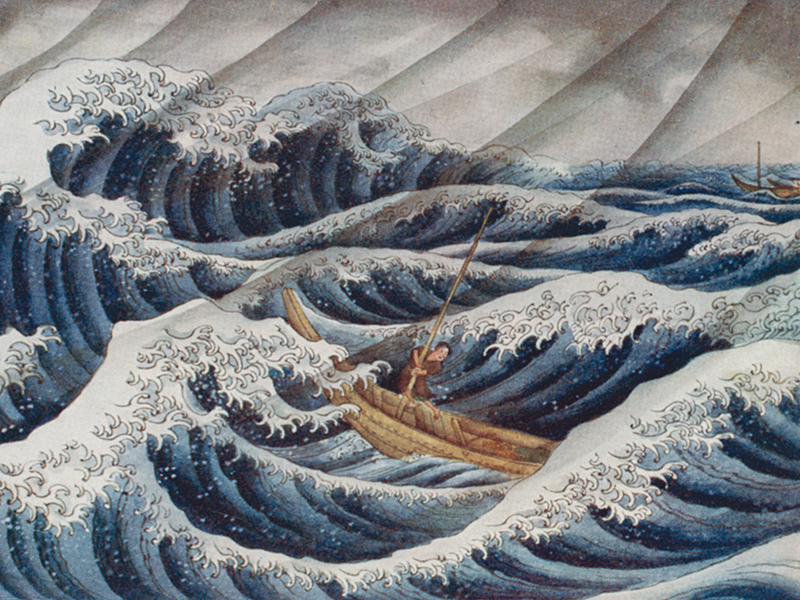
Makino Heinei gets blown away in the storm, an illustration from Ancient Tales & Folklore of Japan by R. Gordon Smith, 1908
Understanding Japan for CAA – Arts & crafts, history, religion & traditions
May 9-20, 2019
CAA is pleased to partner with Martin Randall Travel to offer an exclusive trip for scholars and artists to Japan.
“Understanding Japan for CAA – Arts & Crafts, History, Religion & Traditions” will take place May 9-20, 2019, and will be led by independent Japan scholar and CAA lifetime member, Pauline Chakmakjian.
Designed specifically for CAA members, this extensive tour will take visitors to the heart of Japan to explore its art and architecture, the continuing work of its craftspeople, its natural beauty and heritage, and modern Japan and its position in the world. Beginning in Tokyo, Understanding Japan for CAA promises to be a remarkable opportunity to engage with many aspects of the country. The tour features:
- Modern architecture in Tokyo and the contrasting traditional buildings in Shirakawa and Takayama.
- Stunning Buddhist temples and gardens in Kyoto, and the legendary, ancient shrine at Izumo.
- Traditional arts and crafts in Kanazawa.
- Overnights in a traditional ryokan (Japanese inn) and an onsen hotel (with natural hot spring bathing options).
- An exploration of the Japanese character in history and today, with specialist lectures by Pauline Chakmakjian.
More about Pauline Chakmakjian

Pauline Chakmakjian is an independent lecturer on a variety of subjects related to the history, fine arts and culture of Japan. She lectures for private member societies, corporate entertainment, private homes, universities, cruises, charities and other related organizations including lecture tours in Australia and New Zealand. She holds a BA in English Literature during which she was also awarded a Merit Scholarship in Fine Art, a Diploma in Law, an MA in Modern French Studies and is a member of the Honourable Society of the Inner Temple. Pauline was elected onto the Board of the Japan Society of the United Kingdom from 2008–2014 and the Japan Society of Hawaii from 2015–2017. In 2014, Pauline was appointed a Visit Kyoto Ambassador by the Mayor of the City of Kyoto.
A portion of the proceeds from every trip will support CAA and its mission to advance art and design.
CAA Member Tour of Greece and Italy
posted by CAA — December 07, 2016
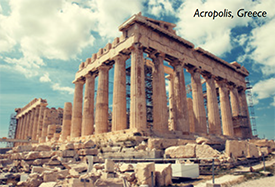 CAA is excited to announce an exclusive offer to its members to spend two weeks exploring the art and art history of Greece and Italy, from June 2 to June 11, 2017. The trip includes stops in Athens, Rome, and Florence. Hosted by CAA Executive Director and CEO, Hunter O’Hanian, this is a once in a lifetime opportunity to explore these majestic cities with fellow CAA members and lovers of art.
CAA is excited to announce an exclusive offer to its members to spend two weeks exploring the art and art history of Greece and Italy, from June 2 to June 11, 2017. The trip includes stops in Athens, Rome, and Florence. Hosted by CAA Executive Director and CEO, Hunter O’Hanian, this is a once in a lifetime opportunity to explore these majestic cities with fellow CAA members and lovers of art.
Local tour guides in each city will lead the group through numerous cultural and historic sites, museums, and galleries. The tour begins in Athens, where highlights include the National Archaeological Museum, the Benaki Museum, Zappio Gardens, the Acropolis and museum, and the Museum of Cycladic Art. In Rome, the tour will visit the Colosseum, Roman Forum, Capitoline Museums, and the Borghese Gallery, among others. Ending in Florence, the tour will stop at the Duomo and Baptistery, Church of Santa Croce, Galleria dell’Accademia, Medici Chapels, Church of San Lorenzo, and the Uffizi Gallery.
Following Florence, you may choose to extend your trip to Venice where the 57th Venice Biennale will be taking place, May 13 through November 26, 2017.
For more information, including rates and a day-by-day tour itinerary, please download and review the Greece & Italy Art and Art History Tour brochure.
A Visit with CAA 2016 Keynote Speaker Tania Bruguera at the Havana Biennial
posted by Christopher Howard — November 04, 2015
Kate Flint, Provost Professor of Art History and English at the University of Southern California in Los Angeles, wrote an article for Public Books on her experiences at the Havana Biennial, which was held May 22–June 22, 2015. In her text, titled “Breaking Down Walls at the Havana Biennial” and published on November 1, Flint describes her encounters with works of art throughout the city. Here is one experience:
Many works of art on show in the “Zona Franca” were overtly political: Michel Mirabal’s distressed and fragmenting Cuban and American flags; Luis Camejo’s delicate drawings of Cuban monuments collapsed, flooded, overgrown at the end of the third millennium; Arlés del Rio’s La necesidad de otros aires (The Need for Other Airs), an entire room filled with breathing tubes hanging from the ceiling, like elongated snorkels, reminding us that being choked by police, or by political or social constraints, or, for that matter, by pollution (and deep concern for the environment was a frequently occurring theme at the Biennale) is a global, as well as a local, concern.
Flint, who traveled to Cuba as part of a trip organized by CAA, participated in a performance work by Tania Bruguera, the artist who will deliver the keynote address during Convocation at the 2016 Annual Conference in Washington, DC. Flint wrote:
During the Biennial’s first weekend, Bruguera staged a hundred-hour reading of Hannah Arendt’s Origins of Totalitarianism. Seated inside her own home, she was breaking no laws (she asked for, but was told she didn’t need, a police permit). The reading—usually in Spanish—was broadcast through loudspeakers, muted at night, to the street outside…. The readings were carried out by those who signed up on a sheet inside space, bare but for a chair, video camera, treats brought by supporters, and a tethered dove…. I was about the 124th person to sign up to read. About an hour later, I was invited to sit in the chair. I’d only intended to read a short paragraph, but no one around seemed to want to take over. Indeed, people seemed to be clearing up their things. Seven pages of Arendt (in Spanish) later, Bruguera herself came over and took the book from me, finished that particular paragraph, and we all exited.
You can also read another article on the same trip to Cuba, written by Katherine Jánszky Michaelsen, professor of art history at the Fashion Institute of Technology in New York, on the CAA website.
The next CAA-sponsored trip is the Turkish-Islamic Art Study Tour, taking place June 3–18, 2016. For more information, please visit CAA’s international tours page.
CAA Members Go to Havana
posted by CAA — August 11, 2015
Last May CAA offered a trip to Cuba to visit the Havana Biennial. In an essay, Katherine Jánszky Michaelsen, a professor of art history at the Fashion Institute of Technology, State University of New York, and a CAA member, describes her experiences in this Caribbean capital city, newly reopened to American citizens.
Outside the airport terminal we’re hit by blinding sunlight and a riot of tropical color—a golden-shower tree, and a row of the famed vintage Cadillacs and Buicks painted in Day-Glo shades of fuchsia, turquoise, and green. All week long sunshine, blue skies, lush vegetation, and vivid colors provide the backdrop of our Havana sojourn; and then there’s the music; on every other street corner someone is making music—not to mention that this is the home of the ever-popular Buena Vista Social Club band.
Timed to coincide with the XII Bienal de la Habana, the CAA trip also overlapped with the onset of the normalization of diplomatic relations between the United States and Cuba. Although Europeans have been traveling to Cuba all along, this was the first year that large numbers of Americans were able to attend the biennial. Celebration was in the air. But testing the climate for change was Tania Bruguera, the dissident Cuban artist and free-speech advocate, who was arrested—not for the first time—at a live reading she held of Hannah Arendt’s 1951 book, The Origins of Totalitarianism. Two members of our group were present at the mêlée.
As tourists we were fortunate to enjoy the expertise and connections of the Cuban-born organizer of the trip, Adolfo Nodal, a former director of the Department of Cultural Affairs in Los Angeles and author of the pioneering book on Cuban art, who has been leading trips to Cuba for a number of years. Thanks to Al, who was one of the producers, we were able to attend the world premiere of the opera Cubanacán: A Revolution in Forms; and we were invited to savor roast pork in the garden of his friend, the artist Kadir López Nieves, with whom he is working on the restoration of Havana’s vintage neon signs. In addition to our spirited and fluently English-speaking guide, Gretell Sintes, another bonus was the considerable experience of CAA member and Xavier University associate professor of art history Alison Fraunhar, also a Cuban art specialist who, for example, arranged a special lecture by Nelson Herrera Ysla, one of the original founders of the Havana biennial in 1984. Finally, traveling with CAA top brass Linda Downs and DeWitt Godfrey, and a busload of like-minded, art-savvy colleagues, ensured the exchange of useful tips, stimulating conversation, and beautiful photographs by Sherman Clarke, among others.
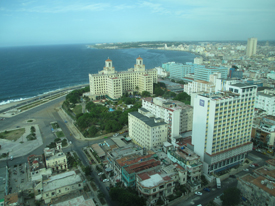 Every morning after partaking of the breakfast buffet that always included heaps of sliced mangoes, papayas, and melons, we assembled in the grand hall of the venerable oceanfront Hotel Nacional, built by McKim, Mead & White in 1930. In the evenings, after a full day of sightseeing, we’d lounge in the palm-tree-lined veranda sipping mojitos to the sound of a female salsa band. As the biennial venues were scattered around the city, it was possible to view historic tourist attractions—like the Plaza de la Revolución, or San Cristóbal cathedral, and at the same time take in a Tino Sehgal performance at the Centro de Arte Contemporáneo Wifredo Lam—or browse and buy prints at the Taller Experimental de Gráfica. Sales transactions can be made entirely on trust: you chose the work, take it with you, and send the check in the agreed amount to the Miami address of a relative or friend of the artist.
Every morning after partaking of the breakfast buffet that always included heaps of sliced mangoes, papayas, and melons, we assembled in the grand hall of the venerable oceanfront Hotel Nacional, built by McKim, Mead & White in 1930. In the evenings, after a full day of sightseeing, we’d lounge in the palm-tree-lined veranda sipping mojitos to the sound of a female salsa band. As the biennial venues were scattered around the city, it was possible to view historic tourist attractions—like the Plaza de la Revolución, or San Cristóbal cathedral, and at the same time take in a Tino Sehgal performance at the Centro de Arte Contemporáneo Wifredo Lam—or browse and buy prints at the Taller Experimental de Gráfica. Sales transactions can be made entirely on trust: you chose the work, take it with you, and send the check in the agreed amount to the Miami address of a relative or friend of the artist.
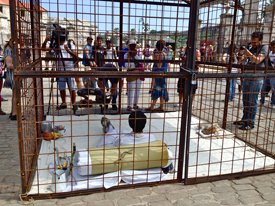 One day in the historic district we stumbled upon a large cage with a man wearing lace tights and stack heels locked inside. We later found out that this was a work by the Indian performance artist Nikhil Chopra, who after three days painting what he saw from behind the bars, hacksawed himself out and walked off to the delight of the cheering crowd that followed him. One particularly hot afternoon, we squeezed like eager sardines into the Church of San Francisco de Paula to watch 82-year-old artist Michelangelo Pistoletto smash large mirrors with a mallet.
One day in the historic district we stumbled upon a large cage with a man wearing lace tights and stack heels locked inside. We later found out that this was a work by the Indian performance artist Nikhil Chopra, who after three days painting what he saw from behind the bars, hacksawed himself out and walked off to the delight of the cheering crowd that followed him. One particularly hot afternoon, we squeezed like eager sardines into the Church of San Francisco de Paula to watch 82-year-old artist Michelangelo Pistoletto smash large mirrors with a mallet.
The Malecón seawall was another venue where art and life mixed seamlessly. To make up for the fact that there is no beach, Arlés del Rio created a fake one complete with sand and thatch-roofed cabañas. All along the five-mile promenade tourists and locals mingled amiably among the assorted works of art; children clambered on sculptures as if they were jungle gyms; and occasionally a wave crashing against the wall would douse us with a welcome cool spray. We were not cautioned, nor evidently did we need to be—public safety was not an issue. We saw no beggars, and apart from traffic cops there was no visible police presence. But evidence of poverty was everywhere. Unlike the spiffy, lovingly restored vintage models lined up in front of our hotel, if you hailed a cab in the street, you were likely to get a Soviet-era Lada with missing window and door-handles, springs poking through the seat, and a rattling engine spewing black fumes.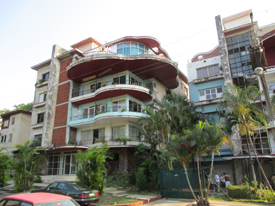 Whole neighborhoods are crumbling and derelict; former single-family houses in residential areas have been chopped up into numerous smaller units; elegant mansions are in ruins; and iconic modernist buildings from the 1950s have peeling paint. Architectural preservationists describe this neglect as “preservation by poverty,” meaning that paradoxically poverty has left extant what urban renewal would have inevitably destroyed. Designers in Havana (and elsewhere) have opportunistically embraced the romantic aesthetic of ruins. For example, Guarida, one of the top restaurants in Havana, is located in a ruined building where laundry hangs on a line in the entrance hall. Likewise, an international group show, Montañas con una esquina rota (Mountains with a Broken Corner), curated by artist Wilfredo Prieto, was staged in the roofless ruin of a former bicycle factory.
Whole neighborhoods are crumbling and derelict; former single-family houses in residential areas have been chopped up into numerous smaller units; elegant mansions are in ruins; and iconic modernist buildings from the 1950s have peeling paint. Architectural preservationists describe this neglect as “preservation by poverty,” meaning that paradoxically poverty has left extant what urban renewal would have inevitably destroyed. Designers in Havana (and elsewhere) have opportunistically embraced the romantic aesthetic of ruins. For example, Guarida, one of the top restaurants in Havana, is located in a ruined building where laundry hangs on a line in the entrance hall. Likewise, an international group show, Montañas con una esquina rota (Mountains with a Broken Corner), curated by artist Wilfredo Prieto, was staged in the roofless ruin of a former bicycle factory.
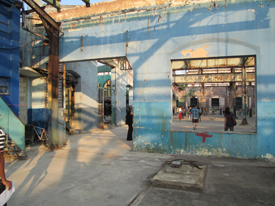 Always at the ready, our tour bus comfortably transported us to outlying sites like Morro Cabaña, the historic colonial fortress on a hill that commands a breathtaking view of the city. A warren of small rooms connected by low barrel-vaulted corridors served as galleries that housed Zona Franca, an exhibition of about one hundred solo and group shows of both acclaimed and emerging Cuban artists. One afternoon we were taken to the Romerillo neighborhood where a year ago Alexis Leyva Machado, the artist known as Kcho, inaugurated (with a rare, surprise public appearance by Fidel Castro) an experimental community project, the Estudio Romerillo. For the biennial he organized an exhibition that took over the entire neighborhood and included artists from all over the world. There is a strong tradition of community service and sharing in Cuba, and established artists who enjoy special privileges are often moved to engage in activities to serve the common good. Carlos Garaicoa, a Cuban artist with an international reputation, is another example. In his spacious studio in a modernist building, he staged a group exhibition to launch Artista x Artista, an international exchange program that will include artist residencies and is based on the Open Studio program he started in Madrid in 2007. Yet another initiative created over the course of a decade for the benefit of the fishing village of Jaimanitas is an extensive and festive work of public art, Fusterlandia. Throughout the neighborhood, starting with his own house, the artist José Rodríguez Fuster painted murals and decorated the walls of dozens of houses with colorful ceramic shards in the manner of Antoni Gaudí.
Always at the ready, our tour bus comfortably transported us to outlying sites like Morro Cabaña, the historic colonial fortress on a hill that commands a breathtaking view of the city. A warren of small rooms connected by low barrel-vaulted corridors served as galleries that housed Zona Franca, an exhibition of about one hundred solo and group shows of both acclaimed and emerging Cuban artists. One afternoon we were taken to the Romerillo neighborhood where a year ago Alexis Leyva Machado, the artist known as Kcho, inaugurated (with a rare, surprise public appearance by Fidel Castro) an experimental community project, the Estudio Romerillo. For the biennial he organized an exhibition that took over the entire neighborhood and included artists from all over the world. There is a strong tradition of community service and sharing in Cuba, and established artists who enjoy special privileges are often moved to engage in activities to serve the common good. Carlos Garaicoa, a Cuban artist with an international reputation, is another example. In his spacious studio in a modernist building, he staged a group exhibition to launch Artista x Artista, an international exchange program that will include artist residencies and is based on the Open Studio program he started in Madrid in 2007. Yet another initiative created over the course of a decade for the benefit of the fishing village of Jaimanitas is an extensive and festive work of public art, Fusterlandia. Throughout the neighborhood, starting with his own house, the artist José Rodríguez Fuster painted murals and decorated the walls of dozens of houses with colorful ceramic shards in the manner of Antoni Gaudí.
Havana’s Museo Nacional de Bellas Artes (MNBA) comprises two separate buildings. The first, a majestic structure built in 1913 devoted to “arte universal,” was the venue for an exhibition titled Wild Noise—a collaboration with the Bronx Museum of the Arts that included an international roster of artists and explored a series of contemporary themes like identity, style, architecture, and community that are relevant to both the Bronx and Havana. Overseen by Bronx Museum director Holly Block, who has been engaged with Cuban art for two decades and is the author of Art Cuba: The New Generation, the exhibition was hailed as the most extensive cultural exchange between the US and Cuba in over fifty years; it will be followed in 2016 by an exhibition at the Bronx Museum organized by the Havana MNBA. A few blocks away, a modernist building from the 1950s that was fully restored and enlarged in the late 1990s showcases Cuban art from colonial times to the present. Except for the conspicuous absence of the obligatory museum book and gift shop, both the building and installation could easily hold their own anywhere in the world.
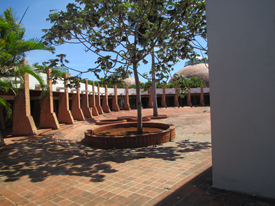 The highlight of the trip for many of us was the campus of the National Art Schools, now known as ISA (Instituto Superior de Arte). It is the subject of a book by John Loomis, Revolution of Forms: Cuba’s Forgotten Art Schools, and a poignant 2011 documentary, Unfinished Spaces, by Alysa Nahmias and Benjamin Murray. Both works tell the story that is also the subject of the opera Cubanacán: A Revolution of Forms that we attended. In 1961, while playing golf at the Havana Country Club in Cubanacán, Fidel Castro and Che Guevara had the idea that the verdant grounds of this symbol of wealth and privilege would be an ideal setting for a complex of tuition-free art schools. Architect Ricardo Porro, charged to build “the most beautiful city of the arts,” enlisted the help of two Italian colleagues Roberto Gottardi and Vittorio Garatti. Of the five proposed schools three (music, ballet, and theater arts) were sadly left unfinished in 1965 when, due to Cuba’s rapprochement with the Soviet Union, the political climate changed drastically. These buildings are now in a state of ruin and overgrown with vegetation. But the schools of modern dance and plastic arts by Porro were completed, recently restored, and continue to be in use.
The highlight of the trip for many of us was the campus of the National Art Schools, now known as ISA (Instituto Superior de Arte). It is the subject of a book by John Loomis, Revolution of Forms: Cuba’s Forgotten Art Schools, and a poignant 2011 documentary, Unfinished Spaces, by Alysa Nahmias and Benjamin Murray. Both works tell the story that is also the subject of the opera Cubanacán: A Revolution of Forms that we attended. In 1961, while playing golf at the Havana Country Club in Cubanacán, Fidel Castro and Che Guevara had the idea that the verdant grounds of this symbol of wealth and privilege would be an ideal setting for a complex of tuition-free art schools. Architect Ricardo Porro, charged to build “the most beautiful city of the arts,” enlisted the help of two Italian colleagues Roberto Gottardi and Vittorio Garatti. Of the five proposed schools three (music, ballet, and theater arts) were sadly left unfinished in 1965 when, due to Cuba’s rapprochement with the Soviet Union, the political climate changed drastically. These buildings are now in a state of ruin and overgrown with vegetation. But the schools of modern dance and plastic arts by Porro were completed, recently restored, and continue to be in use.
The three wide arches of the entranceway of the brick-domed school of plastic arts provided the ideal backdrop for the outdoor performance of Cubanacán by the Cuban composer Roberto Valera and the American librettist Charles Koppelman. This worthy effort, previewed favorably in the New York Times, is an intriguing work in progress that deserves to be developed further, not only because it serves to publicize this unique architectural undertaking.
 It was in the daylight the following day that the building came fully to life. Low-lying, hugging the ground, the stupalike domes of red brick and contrasting white plaster are surrounded by tropical green foliage—it is as strange and unfamiliar-looking as the remains of some unknown, ancient civilization. The inside of the building is bathed in natural light from the oculi in the Catalan-vaulted domes and, due to skillful positioning of corridors and interior spaces, is ventilated and comfortable even in the midday sun. The experience of the building was made even more memorable because art students were present throughout. In keeping with the biennial’s theme of the fusion of art and life, mixed in with official exhibits were working art studios open to the public, where you could engage with the art students. When I asked a young woman whether the building was an inspiration for her, she smiled, and her eyes shining brightly, vigorously nodded her head.
It was in the daylight the following day that the building came fully to life. Low-lying, hugging the ground, the stupalike domes of red brick and contrasting white plaster are surrounded by tropical green foliage—it is as strange and unfamiliar-looking as the remains of some unknown, ancient civilization. The inside of the building is bathed in natural light from the oculi in the Catalan-vaulted domes and, due to skillful positioning of corridors and interior spaces, is ventilated and comfortable even in the midday sun. The experience of the building was made even more memorable because art students were present throughout. In keeping with the biennial’s theme of the fusion of art and life, mixed in with official exhibits were working art studios open to the public, where you could engage with the art students. When I asked a young woman whether the building was an inspiration for her, she smiled, and her eyes shining brightly, vigorously nodded her head.
Captions
Photo 1: View from the Edificio FOCSA with Hotel Nacional and gardens (rear) (photograph by Sherman Clarke)
Photo 2: Nikhil Chopra, performance The Black Pearl, Plaza de Armas, Havana (photograph by Katherine J. Michaelsen)
Photo 3: Modernist buildings in disrepair, Miramar, Havana (photograph by Sherman Clarke)
Photo 4: Group exhibition, curated by artist Wilfredo Prieto in former bicycle factory, Vedado, Havana (photograph by Sherman Clarke)
Photo 5: Inner courtyard, School of Plastic Arts, ISA, Cubanacán, Havana (photograph by Sherman Clarke)
Photo 6: CAA group on steps of Club Habana, Playa, Havana (photograph by Gretell Sintes)
Arts in Turkey Tour for CAA Members
posted by Nia Page — January 17, 2014
 Read Milton Moore’s tour diary from his trip to Turkey in October 2013, organized by Tutku Tours.
Read Milton Moore’s tour diary from his trip to Turkey in October 2013, organized by Tutku Tours.
CAA has partnered with Tutku Tours to provide an exclusive offer for its members to spend two weeks exploring the ancient and contemporary sides of Turkey, from May 27 to June 10, 2014. Highlights of the Arts in Turkey Tour: Yesterday and Today trip include stops in Istanbul, Iznik, Canakkale, Troy, Assos, Ayvalik, Izmir, Pergamum, Ephesus, Kusadasi, Pamukkale, Catalhoyuk, Konya, Cappadocia, and Ankara. This tour is a one-of-a-kind experience that takes visitors on a spectacular journey through ancient and modern Turkey. Visit the workshops of local artists, learn about techniques of ancient art, and take in galleries and museums in some of the world’s oldest cities.
The tour begins with three days in Istanbul—the city on seven hills and the capital of two former empires—where travelers will visit the major attractions, including the Hippodrome, Blue Mosque, and Hagia Sophia, and also get to know the city’s vibrant street life and local art scene. The tour will then visit the Iznick Foundation’s tile factory, the archaeological site of ancient Troy, and the Pergamum acropolis. The city of Izmir, which boasts numerous museums and art galleries, comes next, and later the port city of Ephesus and Pamukkale, near the ancient city of Herapolis. A handful of other exciting stops will happen in the several days before the return flight from Ankara.
In addition to access to cultural and historic sites, the Art of Turkey Tour will provide CAA members with time for rest and relaxation. The group will stop at a carpet school in Ephesus, along with an overnight stay at a spa hotel at the Pamukkale hot springs. The end of the trip includes a stop in Cappadocia, where travelers can explore the Göreme Open-Air Museum, a vast collection of painted cave-churches dating from 1000 AD, and also watch a whirling dervishes ceremony. At the final destination, Ankara, the tour will visit the famed Museum of Anatolian Civilizations.
Getting There: Turkish Airlines provides nonstop, direct flights from the United States and Canada from the following cities: New York, Los Angeles, Washington, DC, Chicago, Houston, and Toronto.
Land and Air Rates: $3,990 per person for a double room; $4,780 per person for a single room.
The Arts in Turkey Tour features include:
- International flight from the US via Turkish Airlines
- Thirteen nights in superior hotels
- Comprehensive sightseeing as specified in the program
- Meals (thirteen dinners, four lunches, daily breakfasts)
- An official, licensed English-speaking guide throughout the tour
- Visits to art galleries
- Transportation in air-conditioned vehicles
- All entry fees to sites and museums
- A hot-air balloon flight in Cappadocia
- Local taxes and service charges
For a detailed, day-by-day tour itinerary, please download and review the Arts in Turkey Tour brochure.
Arts in Turkey Tour: Yesterday and Today
posted by Nia Page — September 12, 2013
 CAA has partnered with Tutku Tours to provide an exclusive offer for its members to spend two weeks exploring the ancient and contemporary sides of Turkey, from May 27 to June 10, 2014. Highlights of the Arts in Turkey Tour: Yesterday and Today trip include stops in Istanbul, Iznik, Canakkale, Troy, Assos, Ayvalik, Izmir, Pergamum, Ephesus, Kusadasi, Pamukkale, Catalhoyuk, Konya, Cappadocia, and Ankara. This tour is a one-of-a-kind experience that takes visitors on a spectacular journey through ancient and modern Turkey. Visit the workshops of local artists, learn about techniques of ancient art, and take in galleries and museums in some of the world’s oldest cities.
CAA has partnered with Tutku Tours to provide an exclusive offer for its members to spend two weeks exploring the ancient and contemporary sides of Turkey, from May 27 to June 10, 2014. Highlights of the Arts in Turkey Tour: Yesterday and Today trip include stops in Istanbul, Iznik, Canakkale, Troy, Assos, Ayvalik, Izmir, Pergamum, Ephesus, Kusadasi, Pamukkale, Catalhoyuk, Konya, Cappadocia, and Ankara. This tour is a one-of-a-kind experience that takes visitors on a spectacular journey through ancient and modern Turkey. Visit the workshops of local artists, learn about techniques of ancient art, and take in galleries and museums in some of the world’s oldest cities.
The tour begins with three days in Istanbul—the city on seven hills and the capital of two former empires—where travelers will visit the major attractions, including the Hippodrome, Blue Mosque, and Hagia Sophia, and also get to know the city’s vibrant street life and local art scene. The tour will then visit the Iznick Foundation’s tile factory, the archaeological site of ancient Troy, and the Pergamum acropolis. The city of Izmir, which boasts numerous museums and art galleries, comes next, and later the port city of Ephesus and Pamukkale, near the ancient city of Herapolis. A handful of other exciting stops will happen in the several days before the return flight from Ankara.
In addition to access to cultural and historic sites, the Art of Turkey Tour will provide CAA members with time for rest and relaxation. The group will stop at a carpet school in Ephesus, along with an overnight stay at a spa hotel at the Pamukkale hot springs. The end of the trip includes a stop in Cappadocia, where travelers can explore the Göreme Open-Air Museum, a vast collection of painted cave-churches dating from 1000 AD, and also watch a whirling dervishes ceremony. At the final destination, Ankara, the tour will visit the famed Museum of Anatolian Civilizations.
Getting There: Turkish Airlines provides nonstop, direct flights from the United States and Canada from the following cities: New York, Los Angeles, Washington, DC, Chicago, Houston, and Toronto.
Land and Air Rates: $3,990 per person for a double room; $4,780 per person for a single room.
The Arts in Turkey Tour features include:
- International flight from the US via Turkish Airlines
- Thirteen nights in superior hotels
- Comprehensive sightseeing as specified in the program
- Meals (thirteen dinners, four lunches, daily breakfasts)
- An official, licensed English-speaking guide throughout the tour
- Visits to art galleries
- Transportation in air-conditioned vehicles
- All entry fees to sites and museums
- A hot-air balloon flight in Cappadocia
- Local taxes and service charges
For a detailed, day-by-day tour itinerary, please download and review the Arts in Turkey Tour brochure.
Art of Turkey: Special Tour for CAA Members
posted by Nia Page — January 15, 2013
 CAA has partnered with Tutku Tours to provide an exclusive offer for its members to spend thirteen days exploring the ancient and contemporary sides of Turkey, from April 26 to May 10, 2013. Highlights of the Art of Turkey trip include stops in Istanbul, Izmir, Cappadocia, Troy, Ephesus, and Pamukkale. The tour begins with three full days in Istanbul—the “city located on two continents”—where travelers will visit the major attractions, including the Blue Mosque and Hagia Sophia, and also get to know the city’s vibrant street life and local art scene.
CAA has partnered with Tutku Tours to provide an exclusive offer for its members to spend thirteen days exploring the ancient and contemporary sides of Turkey, from April 26 to May 10, 2013. Highlights of the Art of Turkey trip include stops in Istanbul, Izmir, Cappadocia, Troy, Ephesus, and Pamukkale. The tour begins with three full days in Istanbul—the “city located on two continents”—where travelers will visit the major attractions, including the Blue Mosque and Hagia Sophia, and also get to know the city’s vibrant street life and local art scene.
Next, the tour will visit the ancient city of Troy and the Pergamum acropolis, and also the less-trodden destination of Ayvalık, a small town on the northwestern Aegean coast of Turkey. After several days of immersion in the ancient world, the group will pay a visit to the second International Izmir Art Biennial, one of the largest international art events in the country that will include more than three hundred artists; Seba Uğurtan, the biennial’s founder, will give tour participants an exclusive overview of the exhibition.
The Art of Turkey Tour will also provide CAA members with time for rest and relaxation. It will stop at the port city of Ephesus to visit a carpet school, along with an overnight stay at a spa hotel at the Pamukkale hot springs. The trip will conclude with a full day in Cappadocia, where travelers will explore the Goreme Open Air Museum, a vast collection of painted cave-churches dating from 1000 AD.
Getting There: Turkish Airlines provides nonstop, direct flights from the United States and Canada, leaving from New York, Los Angeles, Chicago, Washington, DC, and Toronto.
Land and Air Rates: $3,990 per person for a double room; $4,780 per person for a single room.
The Art of Turkey Tour features include:
- International flight from New York, Los Angeles, Chicago, Washington, DC, or Toronto
- Thirteen nights in superior hotels
- Meals (thirteen dinners, four lunches, daily breakfasts)
- All entry fees to museums and sites, including the Izmir Art Biennial
- Transportation and tour guide
- Hot-air balloon flight and a whirling-dervishes ceremony in Cappadocia
For a detailed, day-by-day tour itinerary, please download and review the Art of Turkey brochure. Tutku Tours will host demonstrations and lectures on art in Turkey at its exhibit booth (#100) in the Book and Trade Fair at CAA’s 2013 Annual Conference in New York.
Art of Turkey: An Exclusive Tour for CAA Members
posted by Nia Page — August 30, 2012
 CAA has partnered with Tutku Tours to provide an exclusive offer for its members to spend thirteen days exploring the ancient and contemporary sides of Turkey, from April 26 to May 10, 2013. Highlights of the Art of Turkey trip include stops in Istanbul, Izmir, Cappadocia, Troy, Ephesus, and Pamukkale. The tour begins with three full days in Istanbul—the “city located on two continents”—where travelers will visit the major attractions, including the Blue Mosque and Hagia Sophia, and also get to know the city’s vibrant street life and local art scene.
CAA has partnered with Tutku Tours to provide an exclusive offer for its members to spend thirteen days exploring the ancient and contemporary sides of Turkey, from April 26 to May 10, 2013. Highlights of the Art of Turkey trip include stops in Istanbul, Izmir, Cappadocia, Troy, Ephesus, and Pamukkale. The tour begins with three full days in Istanbul—the “city located on two continents”—where travelers will visit the major attractions, including the Blue Mosque and Hagia Sophia, and also get to know the city’s vibrant street life and local art scene.
Next, the tour will visit the ancient city of Troy and the Pergamum acropolis, and also the less-trodden destination of Ayvalık, a small town on the northwestern Aegean coast of Turkey. After several days of immersion in the ancient world, the group will pay a visit to the second International Izmir Art Biennial, one of the largest international art events in the country that will include more than three hundred artists; Seba Uğurtan, the biennial’s founder, will give tour participants an exclusive overview of the exhibition.
The Art of Turkey Tour will also provide CAA members with time for rest and relaxation. It will stop at the port city of Ephesus to visit a carpet school, along with an overnight stay at a spa hotel at the Pamukkale hot springs. The trip will conclude with a full day in Cappadocia, where travelers will explore the Goreme Open Air Museum, a vast collection of painted cave-churches dating from 1000 AD.
Getting There: Turkish Airlines provides nonstop, direct flights from the United States and Canada, leaving from New York, Los Angeles, Chicago, Washington, DC, and Toronto.
Land and Air Rates: $3,990 per person for a double room; $4,780 per person for a single room.
The Art of Turkey Tour features include:
- International flight from New York, Los Angeles, Chicago, Washington, DC, or Toronto
- Thirteen nights in superior hotels
- Meals (thirteen dinners, four lunches, daily breakfasts)
- All entry fees to museums and sites, including the Izmir Art Biennial
- Transportation and tour guide
- Hot-air balloon flight and a whirling-dervishes ceremony in Cappadocia
For a detailed, day-by-day tour itinerary, please download and review the Art of Turkey brochure. Tutku Tours will host demonstrations and lectures on art in Turkey at its exhibit booth (#100) in the Book and Trade Fair at CAA’s 2013 Annual Conference in New York.


